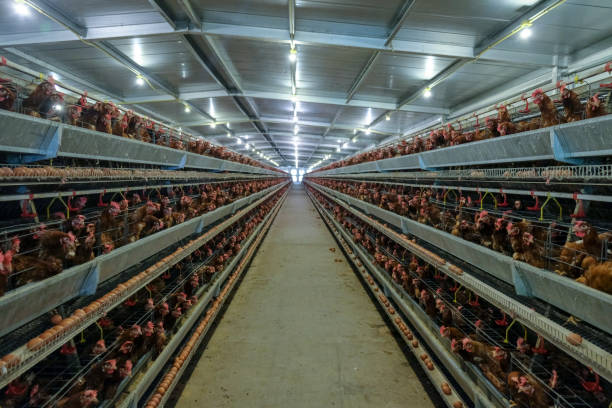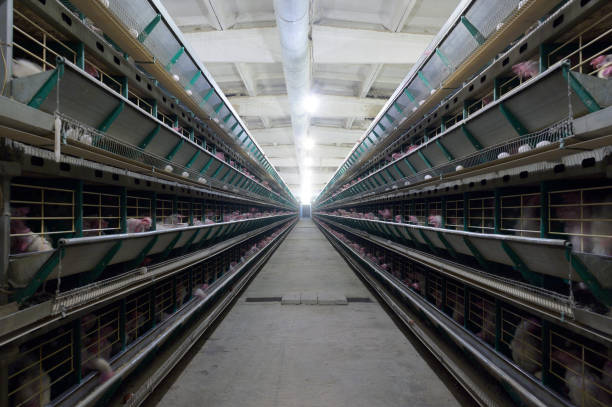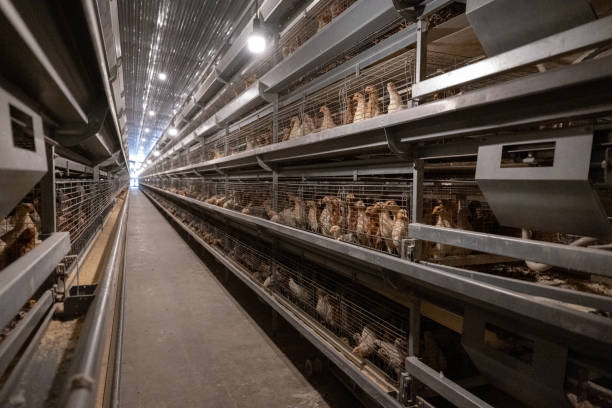
Boost Your Poultry Farm: Top-Rated Chicken Cages for Sale
Boost Your Poultry Farm: Top-Rated Chicken Cages for Sale

For poultry farmers aiming to maximize egg production and enhance broiler growth, selecting the right chicken cages is paramount. High-quality chicken cages not only create a more comfortable and secure environment for your birds but also significantly contribute to operational efficiency, reduced labor costs, and improved overall farm productivity. This article digs deep into the world of chicken cages, exploring the different types available, their benefits, and key considerations for making the right choice for your poultry farm. Whether you’re just starting out or looking to upgrade your existing setup, understanding the ins and outs of chicken cages will set you on the path to a more profitable and sustainable operation.
Why Invest in High-Quality Chicken Cages?
Investing in well-designed and durable chicken cages offers a multitude of advantages that extend far beyond simply containing your birds. Here’s a breakdown of the key benefits:
Improved Bird Health and Welfare: Modern chicken cages are designed with the well-being of the birds in mind. Features like adequate space, proper ventilation, and easy access to food and water contribute to a healthier and less stressed living environment. Reduced stress can lead to better egg production in layers and faster growth rates in broilers.
Increased Egg Production: Layer cages, in particular, are optimized to enhance egg-laying performance. Individual compartments reduce competition and allow for better monitoring of each hen’s production. The sloped floors facilitate easy egg collection, minimizing breakage and contamination.
Better Broiler Growth: Broiler cages offer a controlled environment that promotes rapid and efficient growth. By limiting movement and reducing energy expenditure, broilers can convert feed more effectively, leading to shorter grow-out periods and increased meat yields.
Enhanced Biosecurity: Cages help to isolate birds from the litter and manure, reducing the risk of disease outbreaks. This improved hygiene contributes to a healthier flock and minimizes the need for costly medications and treatments.
Reduced Labor Costs: Automated systems for feeding, watering, and egg collection can significantly reduce the amount of manual labor required on the farm. This frees up your time and resources to focus on other important aspects of your business.
Efficient Space Utilization: Cages allow you to house a larger number of birds in a smaller area compared to free-range or floor-based systems. This is particularly important for farms with limited land availability.
Easy Management and Monitoring: Cages make it easier to monitor the health and performance of individual birds. You can quickly identify and address any issues, such as illness or decreased egg production.
Waste Management: Cage systems often incorporate efficient waste management systems, which help to reduce odor and minimize environmental impact.
Types of Chicken Cages Available for Sale

The market offers a wide array of chicken cages designed to meet the specific needs of different poultry operations. Here’s an overview of the most common types:
Layer Cages: These cages are specifically designed for egg-laying hens. They typically feature multiple tiers and individual compartments for each bird. Key features include sloped floors for easy egg collection, feed and water troughs, and ample space for movement. Layer cages come in various configurations, including A-frame, H-frame, and vertical stacking systems.
A-Frame Layer Cages: These are the most common type, known for their simplicity and affordability. They consist of two sloping sides that meet at the top, forming an “A” shape.
H-Frame Layer Cages: These cages offer greater stability and durability compared to A-frame cages. They are constructed with a sturdy H-shaped frame and are often used in larger-scale operations.
Vertical Stacking Layer Cages: These cages maximize space utilization by stacking multiple tiers vertically. They are ideal for farms with limited floor space.
Broiler Cages: Broiler cages are designed for raising meat chickens. They provide a controlled environment that promotes rapid growth and efficient feed conversion. Broiler cages are typically larger than layer cages to accommodate the larger size of the birds. They also feature easy access to feed and water, as well as ventilation systems to maintain optimal temperature and humidity levels.
Breeder Cages: These cages are used for housing breeding chickens. They are designed to provide a comfortable and secure environment for mating and egg production. Breeder cages often include nesting boxes and other features to promote successful reproduction.
Chick Cages: These cages are designed for raising young chicks. They provide a warm and protected environment that promotes healthy growth and development. Chick cages typically feature wire mesh floors to allow for easy cleaning and drainage.
Custom Chicken Cages: Many suppliers offer custom-designed chicken cages to meet the specific needs of individual farms. These cages can be tailored to fit your available space, bird type, and production goals.
Factors to Consider When Choosing Chicken Cages
Selecting the right chicken cages is a crucial decision that will impact the long-term success of your poultry farm. Here are some key factors to consider:
Bird Type and Age: Different types of chickens have different housing requirements. Choose cages that are specifically designed for the type of bird you are raising (layers, broilers, breeders, or chicks). Also, consider the age of the birds and select cages that are appropriately sized.
Cage Size and Capacity: The size of the cage should be adequate to allow the birds to move freely and comfortably. Overcrowding can lead to stress, disease, and reduced productivity. Ensure that the cage capacity matches your flock size.
Material and Construction: The cages should be constructed from durable, rust-resistant materials that can withstand the rigors of daily use. Galvanized steel is a popular choice for its strength, durability, and corrosion resistance.
Ventilation: Proper ventilation is essential for maintaining a healthy environment inside the cages. The cages should be designed to allow for adequate airflow to remove stale air and prevent the buildup of ammonia and other harmful gases.
Feeding and Watering Systems: Choose cages that are equipped with efficient and reliable feeding and watering systems. These systems should be easy to clean and maintain, and they should provide the birds with access to fresh food and water at all times. Automatic systems can significantly reduce labor costs.
Egg Collection System (for Layer Cages): If you are raising layers, consider cages with an automated egg collection system. This will save you time and labor and reduce the risk of egg breakage.
Waste Management Systems: Efficient waste management is crucial for maintaining hygiene and minimizing environmental impact. Look for cages that are designed to facilitate easy waste removal.
Ease of Cleaning and Maintenance: The cages should be easy to clean and disinfect to prevent the spread of disease. Consider cages with removable parts and smooth surfaces.
Durability and Longevity: Invest in high-quality cages that are built to last. This will save you money in the long run by reducing the need for repairs and replacements.
Cost: Consider your budget and choose cages that offer the best value for your money. Don’t sacrifice quality for price; investing in durable and well-designed cages will pay off in the long run.
Supplier Reputation and Support: Choose a reputable supplier that offers excellent customer support and after-sales service. A reliable supplier can provide valuable advice and assistance with installation, maintenance, and troubleshooting.
Compliance with Regulations: Ensure that the cages you choose comply with all relevant regulations and standards for animal welfare.
Tips for Setting Up Your Chicken Cages
Once you’ve chosen the right chicken cages, proper setup is essential for maximizing their benefits. Here are some tips:
Location: Choose a well-ventilated and dry location for your chicken cages. Avoid areas that are prone to flooding or dampness.
Assembly: Follow the manufacturer’s instructions carefully when assembling the cages. Ensure that all parts are properly secured and that the cages are level.
Ventilation: Ensure that the cages are properly ventilated. If necessary, install fans or other ventilation equipment to improve airflow.
Lighting: Provide adequate lighting for your chickens. This is especially important for layers, as light stimulates egg production.
Temperature Control: Maintain a comfortable temperature inside the cages. Use heaters or coolers as needed to regulate the temperature.
Feeding and Watering: Ensure that the feeding and watering systems are properly installed and functioning. Check them regularly to ensure that the birds have access to fresh food and water.
Waste Management: Implement an efficient waste management system. Remove manure regularly to prevent the buildup of odor and ammonia.

Biosecurity: Implement strict biosecurity measures to prevent the spread of disease. This includes disinfecting the cages regularly, limiting access to the farm, and using foot baths.
Maintaining Your Chicken Cages for Longevity
Proper maintenance is essential for extending the lifespan of your chicken cages and ensuring optimal performance. Here are some key maintenance tips:
Regular Cleaning: Clean the cages regularly to remove manure, feathers, and other debris. This will help to prevent the buildup of bacteria and ammonia.
Disinfection: Disinfect the cages periodically to kill harmful bacteria and viruses. Use a poultry-safe disinfectant.
Rust Prevention: Check the cages regularly for signs of rust. Treat any rust immediately to prevent it from spreading.
Repair Damage: Repair any damage to the cages promptly. This includes fixing broken wires, replacing worn parts, and tightening loose connections.
Lubrication: Lubricate moving parts, such as hinges and latches, to keep them functioning smoothly.
Ventilation System Maintenance: Clean and maintain the ventilation system regularly to ensure that it is functioning properly.
Feeding and Watering System Maintenance: Check the feeding and watering systems regularly to ensure that they are clean and functioning properly.
Pest Control: Implement a pest control program to protect your chickens from rodents, insects, and other pests.
Finding the Right Supplier for Your Chicken Cages
Choosing a reliable supplier is just as important as selecting the right chicken cages. Look for a supplier that offers:
High-Quality Products: The supplier should offer cages that are made from durable materials and designed to meet the specific needs of your poultry operation.
Competitive Prices: The supplier should offer competitive prices without sacrificing quality.
Excellent Customer Service: The supplier should be responsive to your inquiries and provide helpful advice and support.
After-Sales Service: The supplier should offer after-sales service, such as installation assistance, maintenance tips, and troubleshooting support.
Warranty: The supplier should offer a warranty on their products to protect you against defects and malfunctions.
Experience and Expertise: The supplier should have extensive experience and expertise in the poultry industry.
By carefully considering these factors and following these tips, you can choose the right chicken cages for your poultry farm and create a more efficient, profitable, and sustainable operation. Investing in high-quality cages is an investment in the future of your farm and the well-being of your birds.
